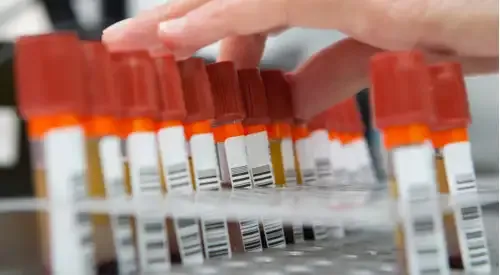Pulmonary embolism
"Prevention and early detection are the best treatments to avoid sequelae".
DR. RAMÓN LECUMBERRI
CODIRECTOR. HEMATOLOGY AND HEMOTHERAPY DEPARTMENT

Pulmonary embolism, also called venous thromboembolic disease, consists of the formation of thrombi in the venous circulatory system that can be released into the general circulation and reach the pulmonary arteries.
The thrombus can develop in a blood vessel anywhere in the body, often in the leg.
Pulmonary embolism is a serious condition that can cause permanent damage to the affected lung, low blood oxygen levels or injury to other organs of the body from not receiving enough oxygen.

What are the symptoms of pulmonary embolism?
Half of the people who have pulmonary embolism have no symptoms. If you do have symptoms, they can include shortness of breath, severe chest pain, coughing up blood, anxiety and agitation.
Early symptoms may also include dizziness, fainting or seizures.
The most common symptoms are:
- Lack of air.
- Acute chest pain.
- Anxiety.
- Dizziness.
Do you have any of these symptoms?
You may have had a pulmonary embolism
What are the causes of pulmonary thromboembolism?
The most common cause of pulmonary embolism is when part of the clot formed in the deep veins of the leg (deep vein thrombosis) breaks off and moves through the bloodstream to other parts of the body.
Thrombus formation usually occurs in situations that cause blood to stagnate, such as:
- Immobilization of one of the limbs due to surgery or fractures.
- Postoperative.
- Prolonged bedding.
- Presence of varicose veins.
- Situations with direct damage to the veins caused by surgery.
- Presence of intravenous catheters.
- There are also other alterations that can facilitate the formation of thrombi such as genetic alterations, some general diseases and the presence of cancer.
How can pulmonary embolism be prevented?
All physical measures that favor venous return, such as elevating the feet from the bed, early mobilization, as well as the different models of bandages, pneumatic compression and elastic stockings; all this to increase the flow of deep leg veins, will be beneficial.
Pharmacological measures are mainly indicated in patients at high risk for VTE. At present, the method of choice is the subcutaneous administration of a low molecular weight heparin preparation.
Among the new substances, pentasaccharide and ximelagatran (thrombin inhibitor) may in the short term be an alternative to low molecular weight heparins.
How is pulmonary thromboembolism diagnosed?

The diagnosis of pulmonary embolism requires the demonstration of thrombi in the venous territory or emboli in pulmonary arteries.
It may require the performance of tests such as: extremity venous echo-doppler, pulmonary ventilation-perfusion scan, thoracic CT-angiography, pulmonary angiography, doppler echocardiography, D-dimer analysis and phlebography.
It should be completed with a study of predisposing factors or facilitators of thrombus formation when the physician suspects that there may be them.
This may include studies of hypercoagulability and, in some cases, the search for tumors using imaging techniques.
How is pulmonary embolism treated?
The fundamental treatment of thromboembolic disease is anticoagulation with heparin or acenocoumarol (Sintrom®), the duration of which depends on the risk the patient has for thrombus formation.
In cases of massive pulmonary embolism, fibrinolytic treatment is required.
When pulmonary embolism is chronic, which occurs more rarely, other treatments may also be required to lower pulmonary pressure, including surgical treatment in some cases (pulmonary thromboendarterectomy).
Where do we treat it?
IN NAVARRE AND MADRID
The Hematology and Hemotherapy Service of the
at the Clínica Universidad de Navarra
The Hematology Service of the Clinic, formed by specialists of recognized national and international prestige, has integrated molecular diagnostic techniques and the use of new personalized treatments in its assistance work, allowing a more precise and fast diagnosis of the hematological diseases.
The joint work of the medical staff and the researcher facilitates the development and application of the new treatments and at the same time the precise evaluation of the result of the treatments.

Why at the Clinica?
- Experts in the development of Cellular Therapy treatments.
- International reference center in lymphomas, multiple myeloma and monoclonal gammopathies.
- Experts in the diagnosis and treatment of hemorrhagic and thrombotic problems.
Our team of professionals



















